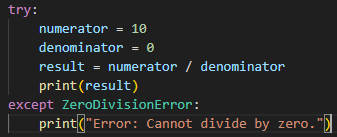📷 Exception Handling Visuals



When working with files, stuff can go wrong — like missing files, permission issues, or corrupted data. Python’s try-except blocks help you catch and handle these errors gracefully without crashing your program.
This demo shows how to catch a FileNotFoundError when trying to read a file that doesn’t exist.
This example catches both file errors and permission errors.
finally BlockThe finally block runs no matter what — great for cleanup like closing files or releasing resources.
try-except to catch specific exceptions or a generic Exception for any error.


